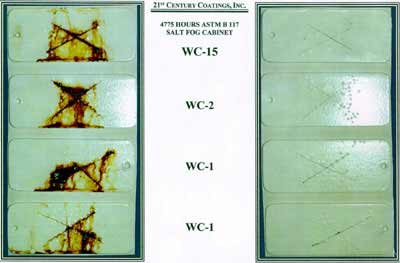
The various FPU coating systems generally exceed the following test requirements.
The paint system when applied to cold rolled steel panels with a thickness of 3 mm and having a class 2 1/2 (Near White) abrasive blast with 35 - 50 microns angular surface profile, must pass 8,000 hours minimum exposure time in a Salt Spray Test to ASTM B 117, with less than 1 mm creep scribe marks.
(ASTM B117) The Salt Fog Cabinet Test measures the resistance of a coating to high humidity and salt corrosion. After 4475 hours, all panels had rust in the scribes as can be seen on the left-hand panels as they exited the cabinet but no sign of any undercut corrosion or scribe creep. This indicates very good long-term resistance to permeation by corrosive waters.
At 4475 hours, one panel was destructively tested for adhesion purposes. The adhesion was such that under film corrosion was not occurring and no pinhole corrosion was evidenced in any tests. (Click on the Picture to see the result)

Paint system must pass 2,000 hours exposure to QUV B bulb to ASTM G 53 with no chalking, cracking, or gloss loss greater than 10%.
Panels were subjected to 8 hours of ultraviolet light at 60deg C, then 4 hours condensation at 45deg C. All panels were coated to a total thickness of 250 microns DFT. Gloss retention figures are more important than initial gloss as the retention percentage is indicative of a coating's ability to retain both color and gloss when exposed to sunlight and rain in either industrial or marine environments. Gloss retention figures in excess of 90% are considered excellent. (Testing thickness was required by the specification)

Paint system must pass minimum 340 inch-lb. impact when tested to ASTM D 2794.
Panels were subjected to both direct and indirect impact of an 3.6 Kg, 12.5mm hemispherical weight dropped from a maximum height of 1.2 M. The maximum indenting force was 384 ft/lbs. None of the panels cracked or otherwise lost adhesion at the maximum indenting force of 384 ft/lbs. NM from either direct or reverse impact. These results indicate excellent resistance to extreme impact damage in industrial or marine environments.
Paint system must pass 1,000 hours with no deterioration when tested in kesternitch cabinet to DIN 50018.
The Kesternich Cabinet Test is a very harsh test of a coating's chemical resistance. All panels were coated to a total thickness of 380 microns DFT and exposed to sulfuric acid fumes and sodium bisulfate fumes at 40deg C for 1,000 hours. The results from this test are indicative of very good, to excellent performance. The photographs demonstrate this performance much better than words. Historically, tests of this type will completely destroy inorganic zincs and aggressively attack organic zincs. (Testing thickness was required by the specification)
Abrasion Resistance. Paint system after 6,000 cycles testing with a CS-17 wheel in a Taber Abraser test to ASTM D 4060, must have less than 30 mg loss.
Moisture Resistance. Paint system must pass 1,000 hours with no change in appearance when tested to ASTDM D 4585.
Paint system must achieve a moisture permeability rate of less than 0.5% when measured by weight.